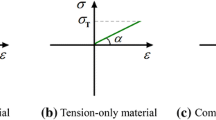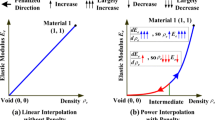Abstract
A modified solid isotropic material with penalization (SIMP) method is proposed for solving layout optimization problems of multiple bi-modulus materials in a continuum. In the present algorithm, each bi-modulus material is replaced by two distinct isotropic materials to avoid structural reanalysis for each update of the design domains. To reduce the error in local stiffness due to the material replacement, the modification factor of each finite element is calculated according to the local stress state and the moduli used in the previous structural analysis. Three numerical examples are considered to demonstrate the validity and applicability of the present approach. Numerical results show that the final layout of materials is determined by factors that include the moduli difference of each bi-modulus material and the difference among material moduli.








Similar content being viewed by others
References
Achtziger W (1996) Truss topology optimization including bar properties different for tension and compression. Struct Optim 12(1):63–74
Alfieri L, Bassi D, Biondini F, Malerba PG (2007) Morphologic evolutionary structural optimization. 7th world congress on structural and multidisciplinary optimization Seoul, Korea, paper A
Allaire G, Jouve F, Toader A-M (2004) Structural optimization using sensitivity analysis and a level-set method. J Comput Phys 194(1):363–393
Allaire G, Dapogny C, Delgado G, Michailidis G (2014) Multi-phase structural optimization via a level set method. Esaim Control Optim Calculus Var 20(2):576–611
Ambartsumyan S (1965) The axisymmetric problem of circular cylindrical shell made of materials with different stiffness in tension and compression. Izvestiya Akademiya Nauk SSSR. Mekhanika 4: 77-85
Andreasen CS, Gersborg AR, Sigmund O (2009) Topology optimization of microfluidic mixers. Int J Numer Methods Fluids 61(5):498–513
Ansys (2013) Ansys. Ansys. http://www.ansyscom, 2013. Assessed April 2015
Baratta A, Corbi I, Corbi O (2015) Analytical formulation of generalized incremental theorems for 2D no-tension solids. Acta Mech. doi:10.1007/s00707-015-1350-2
Bathe K-J (2006) Finite element procedures. Klaus-Jurgen Bathe, United States of America
Bendsoe MP, Sigmund O (2003) Topology optimization: theory, methods and applications. Springer Science & Business Media
Blasques JP, Stolpe M (2012) Multi-material topology optimization of laminated composite beam cross sections. Compos Struct 94(11):3278–3289
Bruggi M (2014) Finite element analysis of no-tension structures as a topology optimization problem. Struct Multidiscip Optim 50(6):957–973
Bruggi M, Duysinx P (2013) A stress-based approach to the optimal design of structures with unilateral behavior of material or supports. Struct Multidiscip Optim 48(2):311–326
Cai K (2011) A simple approach to find optimal topology of a continuum with tension-only or compression-only material. Struct Multidiscip Optim 43(6):827–835
Cai K, Qin QH (2012) A new construction method for a lightweight submerged radial gate. Front Eng Mech Res 1(1):1–7
Cai K, Qin QH, Luo Z, Zhang A (2013) Robust topology optimisation of bi-modulus structures. Comput Aided Des 45(10):1159–1169
Cai K, Gao DY, Qin QH (2014a) Postbuckling analysis of a nonlinear beam with axial functionally graded material. J Eng Math 88:121–136
Cai K, Gao DY, Qin QH (2014b) Postbuckling solutions of hyper-elastic beam by canonical dual finite element method. Math Mech Solids 19(6):659–671
Cai K, Gao Z, Shi J (2014c) Topology optimization of continuum structures with bi-modulus materials. Eng Optim 46(2):244–260
Cai K, Luo ZJ, Qin QH (2014d) Topology optimization of bi-modulus structures using the concept of bone remodeling. Eng Comput 31(7):1361–1378
Chang C, Zheng B, Gea H (2007) Topology optimization for tension/compression only design. Proceedings of the 7th world congress on structural and multidisciplinary optimization. pp 2488–2495
Diaz AR, Sigmund O (2010) A topology optimization method for design of negative permeability metamaterials. Struct Multidiscip Optim 41(2):163–177
Dorn WS (1964) Automatic design of optimal structures. J Mecanique 3:25–52
Du Z, Guo X (2014) Variational principles and the related bounding theorems for bi-modulus materials. J Mech Phys Solids 73:183–211
Dühring MB, Jensen JS, Sigmund O (2008) Acoustic design by topology optimization. J Sound Vib 317(3):557–575
Eschenauer HA, Olhoff N (2001) Topology optimization of continuum structures: a review*. Appl Mech Rev 54(4): 331–390
Gibiansky LV, Sigmund O (2000) Multiphase composites with extremal bulk modulus. J Mech Phys Solids 48(3):461–498
Guan H, Steven G, Xie M (1999) Evolutionary structural optimisation incorporating tension and compression materials. Adv Struct Eng 2:273–288
Guo X, Zhang W, Zhong W (2014a) Stress-related topology optimization of continuum structures involving multi-phase materials. Comput Methods Appl Mech Eng 268:632–655
Guo X, Zhang W, Zhong W (2014b) Doing topology optimization explicitly and geometrically—a new moving morphable components based framework. J Appl Mech 81(8):081009
Han S-Y, Lee S-K (2005) Development of a material mixing method based on evolutionary structural optimization. JSME Int J Ser A 48(3):132–135
Huang X, Xie M (2010) Evolutionary topology optimization of continuum structures: methods and applications. Wiley
Hvejsel CF, Lund E (2011) Material interpolation schemes for unified topology and multi-material optimization. Struct Multidiscip Optim 43(6):811–825
Jones RM (1977) Stress-strain relations for materials with different moduli in tension and compression. AIAA J 15(1):16–23
Kanno Y (2011) Nonsmooth mechanics and convex optimization. CRC Press
Liu S, Qiao H (2011) Topology optimization of continuum structures with different tensile and compressive properties in bridge layout design. Struct Multidiscip Optim 43(3):369–380
Liu Y, Xie Z, Van Humbeeck J, Delaey L (1998) Asymmetry of stress–strain curves under tension and compression for NiTi shape memory alloys. Acta Mater 46(12):4325–4338
Luo Z, Tong L, Ma H (2009) Shape and topology optimization for electrothermomechanical microactuators using level set methods. J Comput Phys 228(9):3173–3181
Maute K, Frangopol DM (2003) Reliability-based design of MEMS mechanisms by topology optimization. Comput Struct 81(8):813–824
Mei Y, Wang X (2004) A level set method for structural topology optimization with multi-constraints and multi-materials. Acta Mech Sinica 20(5):507–518
Mosler J, Cirak F (2009) A variational formulation for finite deformation wrinkling analysis of inelastic membranes. Comput Methods Appl Mech Eng 198(27):2087–2098
Norato JA, Bell BK, Tortorelli DA (2015) A geometry projection method for continuum-based topology optimization with discrete elements. Comput Methods Appl Mech Eng 293:306–327
Osher SJ, Santosa F (2001) Level set methods for optimization problems involving geometry and constraints: I. frequencies of a two-density inhomogeneous drum. J Comput Phys 171(1):272–288
Qin QH (2000) The Trefftz finite and boundary element method. WIT PRESS, Southampton
Qin QH (2005) Trefftz finite element method and its applications. Appl Mech Rev 58(5):316–337
Qin QH, Ye JQ (2004) Thermoelectroelastic solutions for internal bone remodeling under axial and transverse loads. Int J Solids Struct 41(9):2447–2460
Qin QH, Qu C, Ye JQ (2005) Thermoelectroelastic solutions for surface bone remodeling under axial and transverse loads. Biomaterials 26 (33): 6798--6810
Querin OM, Victoria M, Martí P (2010) Topology optimization of truss-like continua with different material properties in tension and compression. Struct Multidiscip Optim 42(1):25–32
Ramani A (2010) A pseudo-sensitivity based discrete-variable approach to structural topology optimization with multiple materials. Struct Multidiscip Optim 41(6):913–934
Roddeman D, Drukker J, Oomens C, Janssen J (1987) The wrinkling of thin membranes: part I—theory. J Appl Mech 54(4):884–887
Rodriguez-Velazquez J, Seireg A (1985) Optimizing the shapes of structures via a rule-based computer program. Comput Mech Eng 4(1):20–28
Rozvany G, Bendsoe M, Kirsch U (1995) Layout optimization of structures. Appl Mech Rev 48(2):41–119
Seldin EJ (1966) Stress-strain properties of polycrystalline graphites in tension and compression at room temperature. Carbon 4(2):177–191
Shi J, Cai K, Qin QH (2014) Optimal mass distribution prediction for human proximal femur with bi-modulus property. Mol Cell Biomech 11(4):235–248
Sigmund O (1994) Materials with prescribed constitutive parameters: an inverse homogenization problem. Int J Solids Struct 31(17):2313–2329
Sigmund O, Torquato S (1999) Design of smart composite materials using topology optimization. Smart Mater Struct 8(3):365
Stegmann J, Lund E (2005) Discrete material optimization of general composite shell structures. Int J Numer Methods Eng 62(14):2009–2027
Stimpson B, Chen R (1993) Measurement of rock elastic moduli in tension and in compression and its practical significance. Can Geotech J 30(2):338–347
Svanberg K (1987) The method of moving asymptotes—a new method for structural optimization. Int J Numer Methods Eng 24(2):359–373
Wang MY, Wang X (2004) “Color” level sets: a multi-phase method for structural topology optimization with multiple materials. Comput Methods Appl Mech Eng 193(6):469–496
Wang MY, Zhou S (2004) Synthesis of shape and topology of multi-material structures with a phase-field method. J Computer-Aided Mater Des 11(2–3):117–138
Wang MY, Wang X, Guo D (2003) A level set method for structural topology optimization. Comput Methods Appl Mech Eng 192(1):227–246
Wang Y, Luo Z, Kang Z, Zhang N (2015) A multi-material level set-based topology and shape optimization method. Comput Methods Appl Mech Eng 283:1570–1586
Xiao Y, Qin QH (2013) Cell based full field displacement calculation for foam material. Proc SIF 2013
Xie YM, Steven GP (1993) A simple evolutionary procedure for structural optimization. Comput Struct 49(5):885–896
Xie YM, Steven GP (1997) Basic evolutionary structural optimization. Springer
Yang Y, Moen CD, Guest JK (2015) Three-dimensional force flow paths and reinforcement design in concrete via stress-dependent truss-continuum topology optimization. J Eng Mech 141(1):04014106
Zenkert D, Burman M (2009) Tension, compression and shear fatigue of a closed cell polymer foam. Compos Sci Technol 69(6):785–792
Zhou M, Rozvany G (1991) The COC algorithm, part II: topological, geometrical and generalized shape optimization. Comput Methods Appl Mech Eng 89(1):309–336
Zhou S, Wang MY (2007) Multimaterial structural topology optimization with a generalized Cahn–Hilliard model of multiphase transition. Struct Multidiscip Optim 33(2):89–111
Zhu L, Zhao H, Song Y (2006) Experimental investigation of the mechanical properties of Takin femoral cortical bone. J Tsinghua Univ 46(2):301
Zhuang C, Xiong Z, Ding H (2007) A level set method for topology optimization of heat conduction problem under multiple load cases. Comput Methods Appl Mech Eng 196(4):1074–1084
Zhuang C, Xiong Z, Ding H (2010) Topology optimization of multi-material for the heat conduction problem based on the level set method. Eng Optim 42(9):811–831
Acknowledgments
Financial support from the National Natural-Science-Foundation of China (Nos. 51279171 and 11372100) and Australian Research Council (No. DP140103137) is gratefully acknowledged.
Author information
Authors and Affiliations
Corresponding author
Rights and permissions
About this article
Cite this article
Cai, K., Cao, J., Shi, J. et al. Optimal layout of multiple bi-modulus materials. Struct Multidisc Optim 53, 801–811 (2016). https://doi.org/10.1007/s00158-015-1365-2
Received:
Revised:
Accepted:
Published:
Issue Date:
DOI: https://doi.org/10.1007/s00158-015-1365-2




